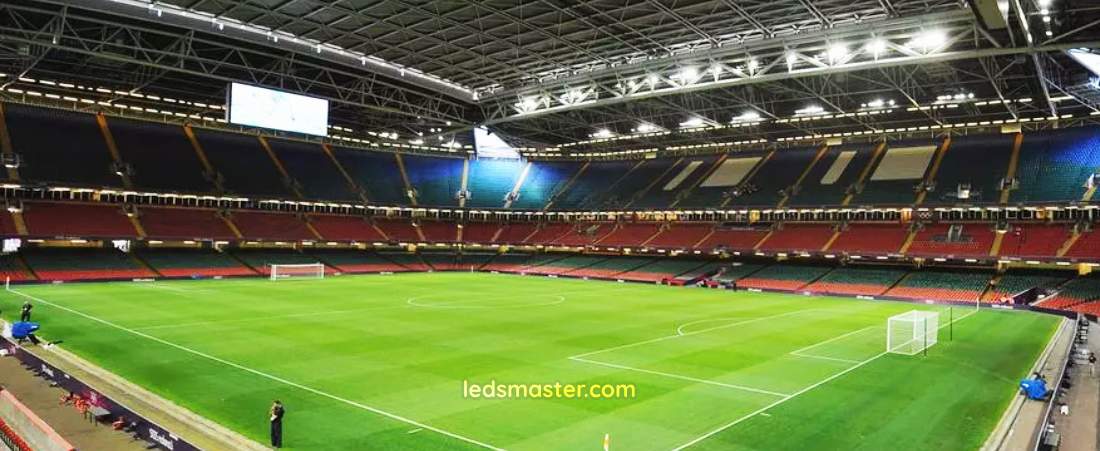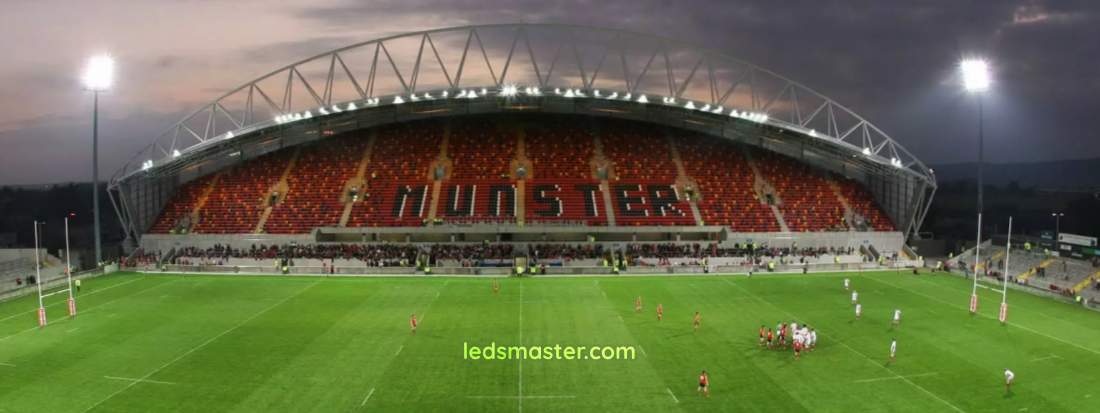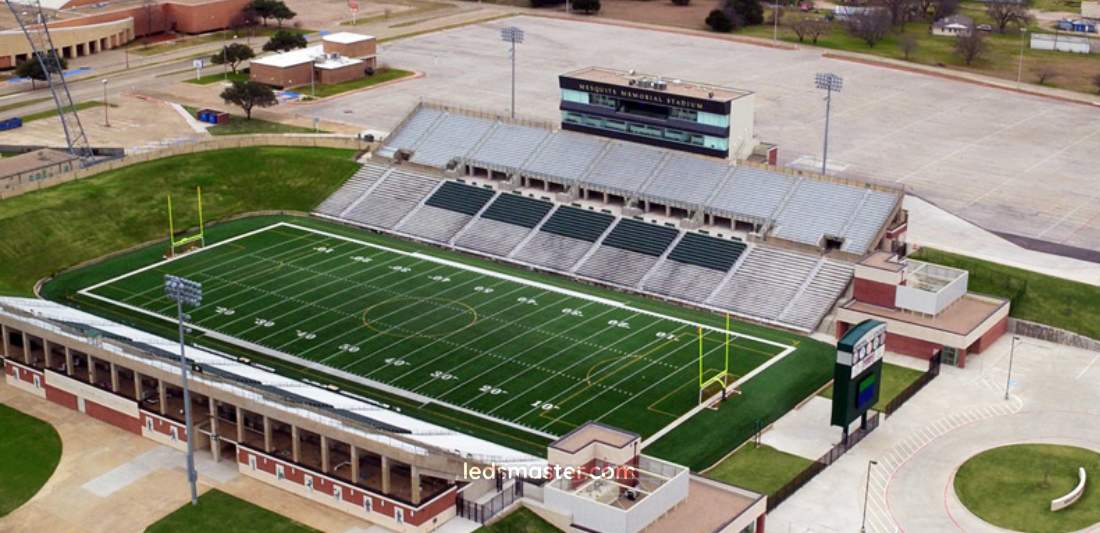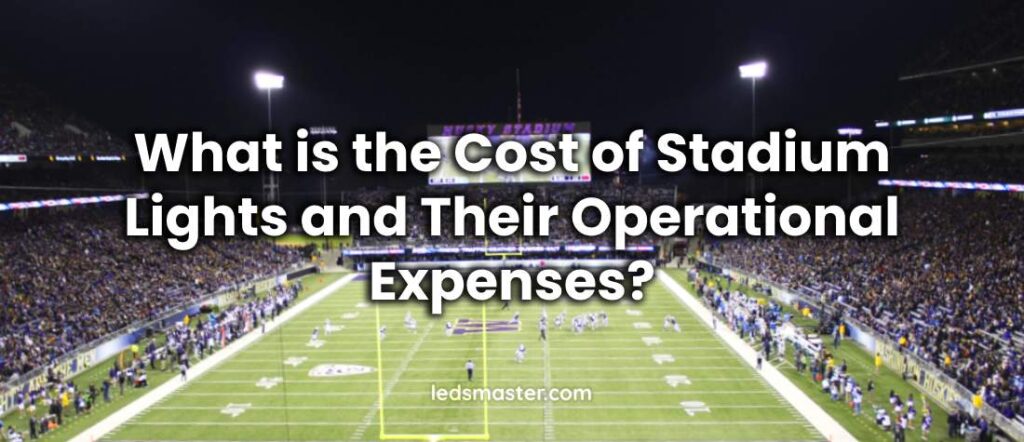Stadium lighting is an essential element for sports events, ensuring visibility for players and spectators alike. Understanding the cost of these lights and their operational expenses is crucial for stadium managers and planners. In this article, we will explore the factors influencing the cost of stadium lights, including initial purchase prices and ongoing operational expenses.
Table of Contents
ToggleInitial Cost of Stadium Lights
The initial cost of stadium lights primarily depends on several factors including the type of lights, the number of lights needed, their wattage, and the specific requirements of the stadium. Stadium lights are designed to provide high-intensity illumination to cover large areas, ensuring excellent visibility for players and spectators during evening or night events. For a standard football stadium, it is common to use between 100 and 200 pieces of LED lights. The wattage of these lights typically ranges from 1000 to 2000 watts, providing the necessary brightness to meet professional sports lighting standards.
Calculating the Range of Total Cost

Based on market research, the price of 1000W LED lights ranges from $0.8 to $2 per watt. Therefore, the cost of a single 1000W LED light can range from $800 to $2000. Similarly, the cost for a 2000W LED light ranges from $1600 to $4000. To calculate the total cost for a stadium, we consider different scenarios based on the number and wattage of the lights.
| Number of Lights | Wattage per Light | Minimum Cost per Light | Maximum Cost per Light | Total Minimum Cost | Total Maximum Cost |
|---|---|---|---|---|---|
| 100 | 1000W | $800 | $2000 | $80,000 | $200,000 |
| 200 | 1000W | $800 | $2000 | $160,000 | $400,000 |
| 100 | 2000W | $1600 | $4000 | $160,000 | $400,000 |
| 200 | 2000W | $1600 | $4000 | $320,000 | $800,000 |
Factors Influencing the Cost of Stadium Lights
The cost of stadium lights is influenced by a variety of factors. Understanding these factors can help stadium planners make informed decisions and optimize their lighting investments. Here we delve into the primary factors affecting the cost: quality and brand, technological features, and bulk purchases and customization.
Quality and Brand
One of the most significant factors influencing the cost of stadium lights is the quality and brand of the lights. Higher quality lights from reputable brands often come at a premium price. However, this additional cost is justified by the numerous benefits these lights offer. Premium lights typically have better performance, meaning they provide brighter and more uniform illumination. This can greatly enhance the visibility on the field and improve the viewing experience for spectators.
Moreover, high-quality lights usually have a longer lifespan. This reduces the frequency of replacements and maintenance, leading to long-term cost savings. Enhanced features such as better heat dissipation are also common in higher-end lights, ensuring they operate efficiently without overheating. Additionally, lights from well-known brands are often more energy-efficient, consuming less power while delivering the same level of brightness. Superior light quality, characterized by better color rendering and reduced glare, further justifies the higher initial investment in these lights.
Technological Features
Technological advancements have significantly impacted the stadium lighting industry, introducing a range of features that enhance the functionality and performance of LED lights. Advanced LED lights may include smart controls, which allow for remote operation and automation of lighting systems. This can lead to more efficient energy use and easier management of lighting schedules.
Dimmability is another valuable feature, enabling the adjustment of light intensity based on the specific requirements of different events. For example, during training sessions, lower light levels may be sufficient, while full illumination is needed for major matches. Color temperature adjustments allow for the customization of the lighting atmosphere, enhancing the overall experience for players and spectators.
Anti-glare technology is particularly important in stadium lighting, as it reduces the discomfort and visual fatigue that can be caused by bright lights. This feature ensures that both athletes and fans can enjoy the event without being distracted or hindered by glare. While these technological features can significantly improve the lighting experience, they also increase the cost of the lights. Investing in such advanced features can be beneficial in the long run, offering greater flexibility, efficiency, and user satisfaction.
Bulk Purchases and Customization
The total cost of stadium lights can also be influenced by the purchasing strategy and the need for customization. Bulk purchase discounts are often available when buying large quantities of lights, which can substantially reduce the overall expenditure. This is particularly relevant for stadium projects where a large number of lights are required.
Customization is another important factor to consider. Stadiums may have specific lighting needs that require custom-designed solutions. This could involve specialized fixtures, mounts, or installation services tailored to the unique architecture and requirements of the stadium. Custom designs ensure that the lighting system is perfectly aligned with the stadium’s needs, providing optimal performance and aesthetics.
However, customization often involves additional costs. Specialized fixtures and mounts may be more expensive than standard options, and custom installation services can add to the labor costs. Despite these additional expenses, customized lighting solutions can offer better performance, efficiency, and satisfaction, making them a worthwhile investment for many stadium projects.
Operational Expenses of Stadium Lights

Beyond the initial purchase cost, operational expenses form a significant aspect of maintaining stadium lighting. These expenses are crucial for budgeting and long-term planning as they can impact the overall cost of running a stadium. The most notable operational expense is the cost of electricity to power the lights. This expense can be calculated based on the wattage of the lights and the cost per kilowatt-hour (kWh) of electricity.
These expenses directly influence the total cost of ownership of stadium lighting over its lifespan. By accurately estimating these costs, stadium managers can plan budgets more effectively, ensuring there are no unexpected financial burdens. Moreover, understanding operational expenses helps in making informed decisions about potential upgrades or changes to the lighting system, aiming for energy efficiency and cost savings.
Calculating the Cost of Running Stadium Lights
To estimate the operational cost of running stadium lights, it is necessary to know three key factors: the total wattage of the lights, the number of hours they are used, and the cost of electricity per kilowatt-hour (kWh). These factors allow us to calculate the total energy consumption and subsequently the cost of powering the lights.
The operational cost of running stadium lights can be calculated by considering the total wattage of the lights, the number of hours they are used, and the cost of electricity per kilowatt-hour (kWh). Let’s break down these calculations for different time periods.
Daily Cost Calculation
For a stadium using 100 pieces of 1000W LED lights (total wattage of 100 kW), used for 5 hours per day:
| Metric | Calculation | Result |
|---|---|---|
| Daily Energy Consumption | 100 kW x 5 hours | 500 kWh |
| Daily Cost of Electricity | 500 kWh x $0.15/kWh | $75 |
Weekly Cost Calculation
Assuming the lights are used for 30 hours per week:
| Metric | Calculation | Result |
|---|---|---|
| Weekly Energy Consumption | 100 kW x 30 hours | 3000 kWh |
| Weekly Cost of Electricity | 3000 kWh x $0.15/kWh | $450 |
Monthly Cost Calculation
Assuming 120 hours of usage per month:
| Metric | Calculation | Result |
|---|---|---|
| Monthly Energy Consumption | 100 kW x 120 hours | 12,000 kWh |
| Monthly Cost of Electricity | 12,000 kWh x $0.15/kWh | $1,800 |
Annual Cost Calculation
For an annual usage of 1440 hours:
| Metric | Calculation | Result |
|---|---|---|
| Annual Energy Consumption | 100 kW x 1440 hours | 144,000 kWh |
| Annual Cost of Electricity | 144,000 kWh x $0.15/kWh | $21,600 |
Total Wattage of the Lights
The total wattage of the lights is the combined wattage of all the lights used in the stadium. This is a crucial factor as it directly determines the total energy consumption. For example, if a stadium uses 100 lights each with a wattage of 1000 watts, the total wattage would be 100,000 watts or 100 kilowatts (kW). This means that for every hour the lights are in use, the stadium consumes 100 kWh of electricity.
To further illustrate, consider a larger setup where the stadium uses 200 lights, each with a wattage of 2000 watts. In this case, the total wattage would be 400,000 watts or 400 kW. This substantial energy consumption reflects the high intensity of illumination required for large-scale events and the importance of efficient lighting solutions.
Here are more examples to clarify the concept:
Example 1 – A stadium with 150 lights, each at 1500 watts:
Total wattage = 150 lights x 1500W = 225,000W = 225 kW
Example 2 – A stadium with 250 lights, each at 1000 watts:
Total wattage = 250 lights x 1000W = 250,000W = 250 kW
These examples show that the total wattage can vary widely based on the number and wattage of the lights, highlighting the importance of careful planning and selection of lighting systems.
Number of Hours the Lights are Used

The operational cost also depends on the number of hours the lights are used. This factor varies based on the usage patterns of the stadium. For instance, the lights might be used for approximately 5 hours per day during evening events. However, it’s essential to consider not only the usage during events but also the additional hours for training sessions, maintenance, and other activities.
To provide a comprehensive view, let’s consider different usage scenarios:
Regular Events
For regular evening events, the stadium lights are typically used for approximately 5 hours per day. Evening events, such as football matches or other sports events, often require full illumination to ensure good visibility for both players and spectators. If a stadium hosts three such events per week, this would translate to 15 hours of usage per week. Over a month, assuming consistent scheduling, this would result in about 60 hours of lighting usage dedicated to regular events. On an annual basis, the total usage for regular events would sum up to 780 hours, considering slight variations for holidays or off-season periods.
Training Sessions
In addition to regular events, stadium lights are often used for training sessions. Training might require lighting for 2 hours per day, five days a week. This additional usage ensures that athletes can practice in conditions similar to those of actual events, which is crucial for performance and safety. Weekly usage for training sessions amounts to 10 hours. Extending this to a monthly basis, the lights would be used for training sessions for about 40 hours each month. Over the course of a year, training sessions would contribute a significant amount of usage hours, totaling 520 hours annually.
Maintenance and Other Activities
Stadium lights are also occasionally used for maintenance and other activities. These activities might include cleaning, repairs, or special events preparation, and they typically add an additional 5 hours of lighting usage per week. While this might seem minor compared to the hours for regular events and training, it still contributes to the total operational cost. Monthly, this equates to 20 additional hours. Annually, maintenance and other activities would account for 260 hours of usage.
Combining these scenarios, the total weekly usage could be around 30 hours. Over a month, this would amount to approximately 120 hours, and over a year, it would be about 1440 hours. These estimates help in accurately calculating the operational costs and planning the budget.
Total Annual Usage
By summing the usage hours for regular events, training sessions, and maintenance, we can estimate the total annual usage of the stadium lights. Regular events account for 780 hours, training sessions for 520 hours, and maintenance and other activities for 260 hours. Thus, the total annual usage is 1560 hours. This comprehensive estimate allows for accurate calculation of the operational costs and aids in effective budget planning.

Strategies to Reduce Stadium Lighting Costs
As demonstrated in the previous section, where we calculated the cost of stadium lighting, it is evident that the expenses associated with operating and maintaining these lights can be substantial. By implementing various strategies, stadium managers can significantly reduce these costs without compromising on the quality of illumination. This article explores effective methods to save on stadium lighting expenses, focusing on technology upgrades, efficient usage patterns, and maintenance best practices.
Upgrading to Energy-Efficient Lighting Systems
Transition to LED Lighting
Upgrading to LED lighting systems represents one of the most effective strategies for reducing stadium lighting costs. LED lights offer significant advantages over traditional lighting options such as metal halide or high-pressure sodium lamps. Unlike their predecessors, LED lights are known for their superior energy efficiency. They consume considerably less electricity while providing equal or even superior illumination. This reduced energy consumption directly translates to lower utility bills, making LED lighting a financially savvy choice for stadiums.
While the initial investment in LED technology can be higher compared to traditional lighting systems, the long-term benefits are substantial. LED lights have a longer lifespan, meaning fewer replacements and lower maintenance costs. They are also more durable, which reduces the frequency and cost of repairs. Over time, the energy savings combined with decreased maintenance expenses make the higher upfront cost of LED lights a worthwhile investment. By transitioning to LED lighting, stadiums can achieve significant cost reductions while enhancing the quality of their lighting.
Smart Lighting Controls
The adoption of smart lighting controls can further optimize the efficiency of stadium lighting systems. These advanced controls include features such as motion sensors, dimmers, and automated scheduling, all of which contribute to reducing energy consumption and operational costs.
Motion sensors play a crucial role in ensuring that stadium lights are only active when needed. By detecting movement and turning the lights on or off accordingly, these sensors prevent unnecessary energy usage during times when the stadium is unoccupied. This feature is particularly beneficial during off-peak hours or when the stadium is not in use.
Dimmers offer another layer of flexibility by allowing the adjustment of light intensity based on specific event requirements. For instance, during less critical periods or practice sessions, the brightness can be reduced, which saves energy without compromising on the quality of illumination.
Automated scheduling provides a systematic approach to managing lighting usage. By programming the lights to turn on or off at predetermined times, stadium managers can prevent lights from being left on unintentionally. This automation helps ensure that energy is used efficiently and only when necessary, further contributing to cost savings.
Optimizing Lighting Design
Conducting a Lighting Audit

Before implementing any changes, it is essential to conduct a thorough lighting audit. This audit involves a detailed evaluation of the current lighting setup to identify areas where lighting is either overused or underutilized. A comprehensive audit will provide valuable insights into how the existing lighting system performs and highlight opportunities for improvement.
Engaging with a professional lighting consultant can significantly enhance the effectiveness of the audit. These experts can analyze the stadium’s lighting needs, assess the efficiency of the current system, and recommend specific adjustments or upgrades. By tailoring their recommendations to the unique requirements of the stadium, consultants can help optimize the lighting design for both performance and cost-efficiency.
Using Reflective Surfaces
Incorporating reflective surfaces within the stadium can further enhance the effectiveness of the lighting system. Reflective materials, such as coatings or panels, can be applied to walls, ceilings, and other structures to improve light distribution. These surfaces work by reflecting and amplifying the light emitted by the fixtures, allowing for more even illumination throughout the stadium.
The use of reflective surfaces reduces the need for additional lighting fixtures, which can lower both installation and operational costs. Additionally, by improving light distribution, reflective surfaces enhance the overall quality of illumination, creating a more visually appealing environment for spectators and players alike. This approach not only contributes to energy savings but also enhances the lighting experience within the stadium.
Implementing Efficient Usage Patterns
Scheduling and Planning
Effective scheduling and planning are key to reducing the operational hours of stadium lights. By carefully organizing events and practices into specific time blocks, stadium managers can minimize the total hours the lights are in use. For example, consolidating multiple training sessions into a single evening can reduce the number of days the lights need to be turned on.
Additionally, advanced scheduling techniques can help align lighting usage with actual needs. For instance, planning events and activities to occur during times when natural light is sufficient can further reduce reliance on artificial lighting. This strategic approach not only lowers energy consumption but also extends the lifespan of the lighting system.
Zone Lighting
Implementing zone lighting allows for more targeted illumination within the stadium. Instead of lighting the entire stadium for smaller events or practice sessions, zone lighting enables selective illumination of only the areas that are actively in use. This method helps to concentrate lighting where it is most needed, reducing the overall energy consumption and operational costs.
Zone lighting can be particularly effective for managing energy use during less critical events or training sessions. By focusing light only on the necessary zones, stadium managers can avoid the expense of illuminating unused areas. This targeted approach not only contributes to cost savings but also enhances the efficiency of the lighting system, ensuring that resources are used in the most effective manner.
Regular Maintenance and Upkeep
Routine Inspections
Routine maintenance and inspections are pivotal to ensuring that stadium lights perform optimally throughout their lifespan. Regular checks help identify potential issues such as faulty wiring, malfunctioning fixtures, or deteriorating lamps before they escalate into more significant problems. For example, detecting and repairing minor faults early can prevent larger, more costly failures that might disrupt stadium operations. Regular inspections also help maintain the efficiency of the lighting system, as undetected issues can lead to increased energy consumption and reduced lighting quality.
A systematic approach to inspections involves not only visual checks but also functional testing of each component of the lighting system. This includes verifying that all fixtures are operating correctly, ensuring that there are no flickering lights, and confirming that all controls and sensors are working as intended. By addressing these issues promptly, stadium managers can prevent energy wastage and extend the lifespan of their lighting system, ultimately leading to cost savings over time.
Cleaning Fixtures
Cleaning lighting fixtures is another essential aspect of routine maintenance. Over time, dirt, dust, and other debris can accumulate on the surfaces of light fixtures, significantly reducing their efficiency. When fixtures are dirty, they may not emit light as effectively, which can lead to increased energy consumption to achieve the desired illumination levels. Regular cleaning ensures that fixtures operate at their maximum output, providing better illumination with less energy.
Establishing a regular cleaning schedule is a practical approach to maintaining the lighting system’s performance. Depending on the environment and usage, fixtures may need to be cleaned monthly, quarterly, or as required. Implementing a systematic cleaning routine not only enhances the efficiency of the lighting system but also contributes to its overall longevity. Keeping fixtures clean and well-maintained helps prevent the need for frequent replacements and repairs, leading to further cost reductions.
Leveraging Technology and Data
Energy Management Systems
Energy Management Systems (EMS) are valuable tools for optimizing stadium lighting operations. These systems provide real-time monitoring and control of lighting usage, allowing stadium managers to track energy consumption, identify inefficiencies, and implement corrective actions. An EMS collects and analyzes data on various aspects of the lighting system, including energy usage patterns, operational hours, and performance metrics.
By leveraging the insights provided by an EMS, stadium managers can make informed decisions to improve energy efficiency. For instance, the system might reveal that certain fixtures are consuming more energy than expected or that specific areas of the stadium are over-lit. Armed with this information, managers can adjust lighting configurations, implement energy-saving practices, or invest in upgrades to enhance overall efficiency. The ability to monitor and control lighting in real-time ensures that energy resources are used judiciously, leading to substantial cost savings.
Predictive Maintenance
Predictive maintenance is an advanced approach that utilizes data analytics and machine learning to forecast when lighting equipment is likely to fail or require servicing. Unlike traditional maintenance methods, which often involve reactive repairs after a problem occurs, predictive maintenance proactively addresses issues before they impact the lighting system’s performance.
By analyzing historical data and monitoring real-time conditions, predictive maintenance systems can identify patterns and anomalies that indicate potential failures. For example, if a particular fixture is showing signs of reduced efficiency or increased wear, the system can alert maintenance personnel to inspect and address the issue before it results in a failure. This proactive approach minimizes downtime, reduces repair costs, and ensures that the lighting system remains in optimal condition. Predictive maintenance helps prevent costly disruptions and extends the lifespan of lighting equipment.
Financial Incentives and Rebates
Government Programs
Many governments and local authorities offer financial incentives and rebates to encourage the adoption of energy-efficient technologies, including LED lighting for stadiums. These programs are designed to offset the initial costs of upgrading to more efficient lighting systems, making it more financially accessible for stadium managers to invest in energy-saving solutions.
Stadium managers should actively explore available government programs and incentives that support the transition to energy-efficient lighting. These programs may include grants, tax credits, or direct rebates on the cost of new lighting systems. By taking advantage of these financial incentives, stadiums can reduce their capital expenditure and achieve a faster return on investment. Additionally, government programs often aim to promote sustainability and energy conservation, aligning with broader environmental goals.
Utility Company Rebates
Utility companies frequently offer rebates for the installation of energy-efficient lighting systems. These rebates are designed to encourage customers to adopt technologies that reduce overall energy consumption. By partnering with their utility provider, stadium managers can benefit from these programs and lower the financial burden of upgrading their lighting systems.
Utility company rebates can vary in terms of the amount and eligibility criteria. Stadium managers should research the specific rebate programs offered by their utility provider and ensure they meet the requirements for participation. Applying for these rebates can lead to substantial savings on the cost of new lighting equipment and help offset the expenses associated with installation. Leveraging utility company rebates is an effective way to reduce the overall investment required for energy-efficient upgrades.
Educating Stakeholders
Training Staff
Educating stadium staff about the importance of energy efficiency and proper lighting management is crucial for achieving long-term cost savings. Training programs can provide staff with the knowledge and skills needed to operate and maintain the lighting system effectively. Well-informed staff can identify potential issues early, implement energy-saving practices, and contribute to the overall efficiency of the lighting system.
Training should cover various aspects of lighting management, including the operation of smart controls, understanding energy usage patterns, and performing routine maintenance tasks. By equipping staff with the necessary expertise, stadium managers can ensure that the lighting system is managed effectively and that energy-saving measures are consistently applied.
Raising Awareness
Raising awareness among all stakeholders, including event organizers, athletes, and spectators, is an important step in fostering a culture of sustainability within the stadium. By highlighting the benefits of energy-efficient lighting and promoting responsible usage practices, stadium managers can encourage collective efforts to reduce operational costs.
Communicating the advantages of energy-efficient lighting and the impact of energy-saving initiatives can help build support for sustainability efforts. Encouraging stakeholders to participate in and advocate for energy-efficient practices can lead to a more collaborative approach to managing lighting costs. Raising awareness not only contributes to cost reduction but also enhances the overall commitment to environmental sustainability within the stadium community.
Conclusion
Stadium lighting plays a key role in providing clear visibility for sports events, impacting both players and spectators. This article has examined the various costs associated with stadium lighting, including initial purchase, installation, and ongoing operational expenses. Factors such as light types, wattage, and advanced features influence these costs. Strategies for reducing expenses, including energy-efficient upgrades and smart controls, have also been discussed. By understanding and managing these aspects, stadium managers can make informed decisions to enhance both performance and cost-effectiveness.

